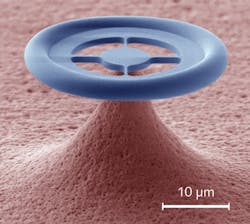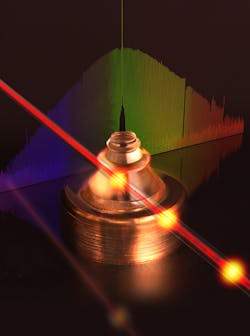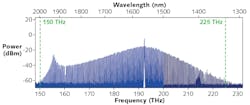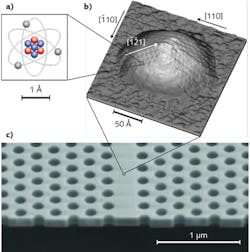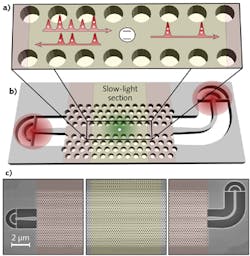Diode Lasers: Exploring micro- and nanostructures with tunable diode lasers
RUDOLF NEUHAUS
Micro- and nanostructures are becoming increasingly important for fundamental research and applied quantum technology. Prominent examples of such structures are microcavities and quantum dots, and examples of important applications include single or entangled photon sources, qubits for quantum computers, and various sensors. The structures also enable investigations at the quantum limit, such as quantum oscillations in microcavities, quantum electrodynamics (QED) with quantum dots, or even cavity QED studies with single quantum dots in cavities.
Many applications require resonant optical excitation with suitable tunable continuous-wave (CW) lasers. By optically pumping microcavities at the right wavelength, one can even create microscopic coherent frequency combs and short optical pulses—a very promising application that is expected to have significant impact on photonics.
Microcavities
Quantum properties are usually not observable in macroscopic objects because of environmental decoherence unless specific sample geometries and cooling are utilized. Employing microcavities, for example, is one possibility to observe quantum effects in relatively large, micrometer-scaled structures. Figure 1 illustrates an isolated, donut-shaped, ~30-μm-diameter glass microcavity that combines a macroscopic mechanical oscillator and a ring-shaped, high-Q optical cavity. Light, coupled into the cavity via an evanescent field, bounces off the walls of the donut by total internal reflection, transferring a small force on the structure by radiation pressure.
In this way, the coupled light can influence the vibrational behavior of the structure and vice versa. This property turns microcavities into exciting objects for quantum research. For example, researchers observed such parametric coupling between light and mechanical oscillations,1 and have also used a sensor that is based on optomechanical coupling for active feedback cooling of such a microcavity.2
Because of their small size, the free spectral range of microcavities is relatively large and tiny-sized deviations cause large spectral shifts of the cavity resonances. So, a widely mode-hop-free tunable laser is an invaluable tool to find and study the resonance frequencies of microcavities or to scan across more than a single free spectral range of the cavity. In addition, the laser has to have low noise in power and frequency to avoid spuriously exciting mechanical oscillations where they are not wanted.
The dependence of the microcavity resonance frequencies on size and other environmental parameters can be exploited for a promising application: label-free detection of single biological molecules in solution. This is enabled using a microtoroid optical resonator in combination with a widely tunable mode-hop-free laser (such as Toptica's DLC CTL). Researchers have described how such a laser is frequency-stabilized to a microtoroid optical resonator and how shifts of the optical resonance frequency caused by molecules binding to the resonator are observed.3 In this way, particles with radii between 2 and 100 nm are detected and distinguished.
The results are further extended toward creating a noninvasive tumor biopsy assay, and provide a basis for an optical mass spectrometer in solution. For this application, not only is wide mode-hop-free tuning required, but also the ability to conveniently stabilize the laser to a microcavity. The CTL laser, for example, has built-in, all-digital stabilization electronics and, optionally, utilizes a high bandwidth analog or fast digital locking electronics.Microresonator-based frequency combs
Microresonators are also increasingly exploited to create optical frequency combs. Because of the small mode volume of the guided optical field and high Q factors up to 1010, the intensities in these resonators get so high that nonlinear effects become very strong. A microresonator can convert CW excitation light into other frequency components via nonlinear four-wave mixing and thereby create a frequency comb (see Fig. 2).Crystal-based microresonators are especially promising, as they feature the highest Q factors. To date, they have only been pumped with low-noise fiber lasers. Such fiber lasers are not widely tunable, and conventional tunable diode lasers were not suitable because of their higher noise. However, a new generation of continuously tunable diode lasers now features ultra-low-noise current drivers and a laser resonator that allow for narrow linewidths below 10 kHz with low drifts. With these tunable diode lasers, even crystal-based microcombs can be pumped. Utilizing high-bandwidth active frequency stabilization, the linewidth of the lasers can be reduced to the 1 Hz level to study effects of noise in the pump laser on the microcombs.
Characterizing dispersion in microresonators is extremely important for designing them with ideal properties. Here, the ultimate tool is a mode-hop-free tunable laser locked to a stabilized comb5 that is shifted in a very controlled fashion.6
Quantum dots
Semiconductor quantum dots are of nanometer size in three dimensions such that their electronic states are quantized because of tight confinement. These quantum dots also show other single atom-like properties, such as strong photon antibunching and near lifetime-limited linewidth, and are often called artificial atoms. They are interesting systems with which to realize qubits, and semiconductor quantum dots are especially promising candidates for scalable quantum computers since semiconductor processing is well understood. Unlike real atoms, semiconductor quantum dots can be grown in a controlled fashion in the solid state, and other structures like photonic-crystal cavities and waveguides can be built around them (see Fig. 5).Resonant optical excitation of quantum dot states is crucial in particular for coherent state manipulation and detection. However, because of the intrinsically random growth process, all quantum dots are slightly different in size and therefore feature different optical resonance frequencies. To find and resonantly excite the optical transitions of a single quantum dot, a widely mode-hop-free, tunable narrowband laser is an ideal tool.
This is especially true for coupled quantum dots. En route to scalable qubit arrays, coupled quantum dots have recently raised considerable interest. Electron transport measurements on coupled quantum dots have demonstrated spin-sensitive coupling and manipulation of electron and nuclear spins, and optical spectra of coupled excitons have been measured and calculated in self-assembled coupled quantum dots.
One approach is to grow self-assembled, coupled quantum dots on top of each other. The interdot coupling in such quantum dot molecules can be dominated by both electron-hole exchange interaction and electron-electron exchange coupling. Changing the quantum dot charging state via their gate voltage then switches between these two mechanisms and changes/controls the coupling strength.7
This variable coupling strength makes such double quantum dots interesting for qubits and quantum computing applications. Their optical resonances, however, can differ by several tens of nanometers (approximately 10 THz)—to resonantly excite both quantum dots again, a widely tunable, mode-hop-free laser is required to easily change from one dot to the other.
Quantum dots in photonic nanostructures
An important aspect for quantum-optics experiments at the single-photon level is to strongly enhance and control the interaction between light and matter such that an emitted single photon preferentially couples to one well-defined optical mode. By integrating quantum dots into other semiconductor structures such as waveguides or photonic-crystal structures (e.g., cavities), even cavity QED experiments are possible without the need for trapping atoms.
Photonic nanostructures provide a means of tailoring the interaction between light and matter. They enable a range of experiments such as spontaneous-emission control, modified Lamb shifts, and enhanced dipole-dipole interaction, as well as highly efficient single-photon sources and very large nonlinearities.
By integrating a quantum dot into a photonic-crystal waveguide, for example, researchers at the Niels Bohr Institute in Copenhagen were able to demonstrate nonlinear optics at the single-photon level-single photons were reflected by the quantum dot while multiple photons would pass (see Fig. 6).8 Such nonlinear interactions between photons enable logic operations for both classical and quantum-information technology, paving the way toward scalable waveguide-based photonics quantum-computing architectures.The micro, nano, and quantum applications and experiments discussed here have one thing in common—they require widely mode-hop-free tunable lasers. A new generation of external cavity diode lasers (ECDLs) can provide very wide tuning with extremely high resolution, while at the same time showing narrow linewidth as well as low noise and drift. In part, these improved properties stem from an all-digital controller, which ensures single-mode operation in an active feedback loop and the ability to automatically optimize the laser cavity if necessary.
With the latest improvements in the development of tunable diode lasers, exploring the micro-, nano-, and quantum worlds becomes much more convenient. Some of the topics covered here might have quite an impact on future technology developments when, for example, microcombs are placed in cell phones or cars while their satellite communication is protected by quantum encryption, realized by quantum dots in photonic crystals.
REFERENCES
1. E. Verhagen, S. Deléglise, S. Weis, A. Schliesser, and T. J. Kippenberg, Nature, 482, 63-67 (2012).
2. D. Wilson, V. Sudhir, N. Piro, and T. J. Ghadimi, Nature, 524, 325-329 (2015).
3. T.-T. Su, "Label-free detection of single biological molecules using microtoroid optical resonators," dissertation, California Institute of Technology, Pasadena, CA (2014).
4. V. Brasch et al., Science, 351, 6271, 357 (2016).
5. T. Puppe et al., Opt. Lett., 41, 8, 1877-1880 (2016).
6. R. Neuhaus et al., "1THz synchronous tuning of two optical synthesizers," Proc. SPIE, 9900, 99001E (Apr. 29, 2016).
7. S. Fält et al., Phys. Rev. Lett., 100, 106401 (2008).
8. A. Javadi et al., NatureCommun., 6, 8655 (2015).
9. P. Lodahl, S. Mahmoodian, and S. Stobbe, Rev. Mod. Phys., 87, 347 (2015).
Rudolf Neuhaus is product manager, scientific diode lasers at Toptica Photonics, Graefelfing, Germany; e-mail: [email protected]; www.toptica.com.
